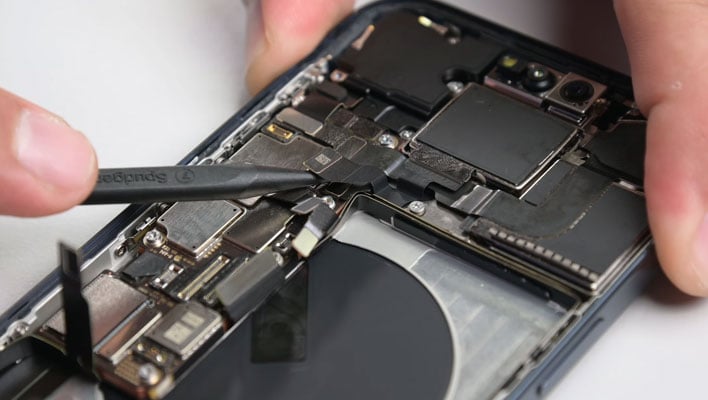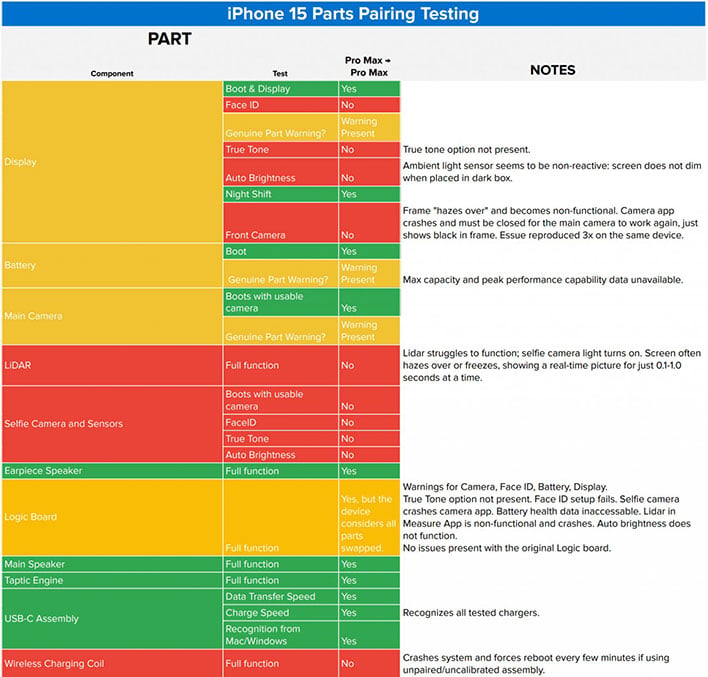iPhone 15 Pro Max Slammed In Teardown Analysis Over Apple's Draconian Repair Rules

Try to hold back your surprise but Apple might not be the right-to-repair champion you hoped it might become, even after recently penning a letter in support of California's proposed right-to-repair bill. This is evidenced in a teardown of the iPhone 15 Pro Max. While not without some redeeming qualities, replacing parts in the iPhone 15 Pro Max left the folks at iFixIt lamenting a "dystopian future that science fiction authors warned us about, where DRM infected every part of our lives." Yikes.
Forget about Denuvo for a moment, the site's beef with Apple is over its insistence on authenticating parts for replacement or else risk having otherwise sound repairs not function like they should. This all comes to a head in a disconcerting chart outlining what issues iFixIt ran into for numerous replacement parts, including the front and rear cameras, display, and even the battery.
Only a small handful of parts can be replaced without worrying about an authentication handshake. For example, the main speaker and taptic engine both work as expected when swapping either or both of those out. Other parts run the gamut from minor to headache-inducing issues. For example, after replacing the wireless charging coil on the iPhone 15 Pro Max, iFixit says it ran into system crashes and forced reboots every few minutes (if using unpaired/uncalibrated assembly).
"Parts pairing in these models extends beyond mere mechanical compatibility, requiring authentication and pairing through Apple’s System Configuration tool, further limiting genuine replacements to Apple-blessed ones and substantially impacting independent repair enterprises and the overarching issue of e-waste," iFixIt says.
In another example, the teardown gurus said they acquired two iPhone 15 Pro Max models and swapped the LiDAR modules between them. After doing so, the camera app would only briefly load before crashing.
DRM aside, getting into the iPhone 15 Pro Max is a now-familiar process—heat the screen to loosen the adhesive, then use a suction tool and plastic pick to pry it apart. Once inside, the battery is accessible but a bit difficult to remove courtesy of three hard-to-reach pull tabs tucked inconveniently inside the well. Removing the speaker and taptic engine eases the process.
Taking out the camera assembly proved much easier, as it only required removing three Phillips screws. What's more, the screws this time around are "much less flimsy and delicate" than in past iterations.
The iPhone 15 Pro Max also garnered praise for having its own version of the removable back cover (separate from the non-Pro models). This was deemed a "win" for consumers because in the past, back glass repairs were "outrageously expensive" on the top SKUs, sometimes in the neighborhood of $550.
When the dust settled, the iPhone 15 Pro Max with its "great design undermined by parts pairing" emerged with a dismal 4 out of 10 repairability score. Likewise, iFixIt retroactively downgraded the iPhone 14's repair score from a 7/10 to 4/10 to reflect a change in iFixIt's scoring, which now takes into accounts Apple's parts paring practice.
"It’s clearly time for Apple to abandon parts pairing... A part installed in a phone should just work. Ever since we invented interchangeable parts in the 1800s, parts have been swappable between products. Software shouldn’t be an obstacle to harvesting parts, or using aftermarket parts for that matter," iFixIt concludes.
Having purportedly spent over $10,000 on iPhone models over just the past few days to systematically test components, iFixIt says it will not be purchasing further models for its team for internal use, as it doesn't buy items that score below a 5/10.


